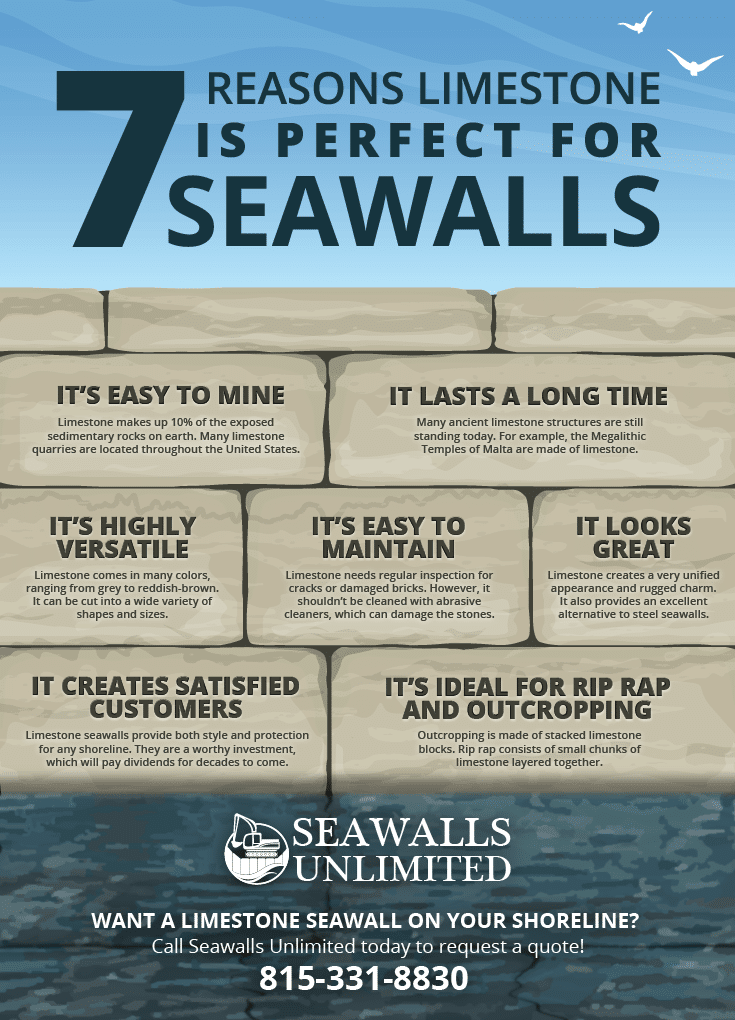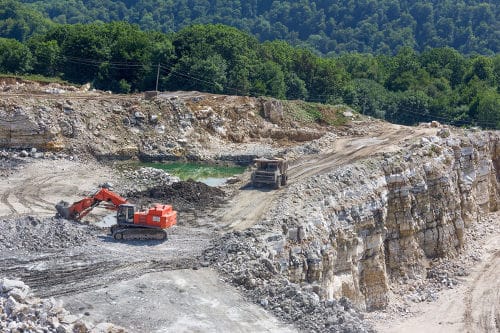Learn About Our High-Quality Retaining Wall Blocks
When you build a seawall, you want it to stay standing for many years to come. That means it has to be made of high-quality materials. So, naturally, many seawall owners want to know what type of retaining wall blocks will make their seawalls last the longest.
At Seawalls Unlimited, we have discovered that the perfect material for seawall longevity is limestone. Read on to learn about the limestone we use in our seawalls, where it comes from, and why it’s a suitable building material.
Where Do Our Retaining Wall Blocks Come From?

At the quarry, they mine the limestone and cut it into blocks with the desired dimensions. From there, they ship the retaining wall blocks to Seawalls Unlimited. We then use these stones for our outcropping and rip rap.
So, what is limestone?
What is Limestone and Why Do We Use It?
Limestone is a sedimentary rock. It contains tiny pieces of bone from marine fossils and consists of at least 80% calcium carbonate.
This stone is popular as a building material for many reasons. For one, it’s easy to mine because it makes up about 10% of the sedimentary rocks exposed on the earth’s surface. It also comes in a range of colors, and we can cut it to a wide variety of finishes, making it very versatile.
Limestone is also extremely sturdy. Many of the oldest human structures are made of limestone and are still standing today. For example, the Megalithic Temples of Malta, some of the oldest free-standing structures in existence are made of limestone. For this reason, you can be sure that limestone structures will last a lifetime.
What Kind of Seawalls Do We Build from Limestone?
Seawalls Unlimited offers three main types of seawalls: steel, outcropping, and rip rap. We use limestone to create the latter two types.
To build outcropping, we layer and stack many limestone blocks together to form a barrier on the coastline. Though the stones are somewhat flat to make stacking easier, each one still has a slightly irregular shape, giving each stone a bit of individuality. So, when we stack the retaining wall blocks together, you get a seawall that looks unified and yet still retains some rugged charm.
Rip rap, also known as shot rock, rubble, or rock armor, consists of smaller chunks of stone layered together. It’s one of the most natural-looking seawalls and one of the best for supporting plant life. When we design rip rap, we determine the size of the stones based on the seawall’s environment. Smaller stones are best for ponds and no-wake zones; whereas, larger sizes are ideal for inland lake shorelines and riverbanks.
Both of these seawalls feature our high-quality limestone retaining wall blocks. They offer a more natural and aesthetically-pleasing alternative to waterfront property owners who would rather not install a steel seawall.
What Precautions Does Limestone Require?
Limestone seawalls provide security because they last for decades on end. However, there are also precautions you should take to keep your wall in good shape. Here are some red flags to watch out for if you have rip rap or outcropping made of limestone.
Replace Broken Stones to Keep Your Rip Rap Fresh
Rip rap seawalls lose their effectiveness when their stones get damaged or break into smaller stones. So, to maintain them you should inspect the walls regularly for fractured rocks. When you find them, replace them with fresh stones. It’s a simple as that.
Avoid Cleaning Your Outcropping
Similarly, maintaining your outcropping requires inspecting the stones to make sure they’re in good shape. However, one thing we would caution you against is cleaning your outcropping with an abrasive cleaner. The reason for this is limestone is vulnerable to acids. So, if you use an acidic cleaner, such as one containing citrus, vinegar, or ammonia, it’ll eat away at the surface of the stone. Doing this can negatively alter the appearance of the retaining wall blocks. Furthermore, it can roughen the surface of the blocks, making them prone to hold more dirt and algae in the tiny nooks and crannies. Pressure washing causes similar problems.
It’s unlikely this will impact the structural stability of the wall, but it will defeat the purpose of cleaning and change the appearance of the stone. You also risk chemical runoff entering the adjacent body of water. So it’s best to leave the outcropping alone and let nature do the cleaning for you. We think the rugged natural look of the stone is the appeal of these types of seawalls, anyway.
Want to Beautify Your Shoreline with Limestone?
A limestone seawall is a perfect fit for any shoreline. The material is durable, long-lasting, and looks great in any natural environment. We can use limestone to build outcropping or rip rap that will pay dividends for many years to come. Give us a call today at 815-331-8830 to request a quote.
For examples of beautiful limestone seawalls in the Chicago area, check out the outcropping and rip rap photos in our project gallery!
Editor’s note: This blog was originally published on March 21, 2018, and updated on September 27, 2018.

